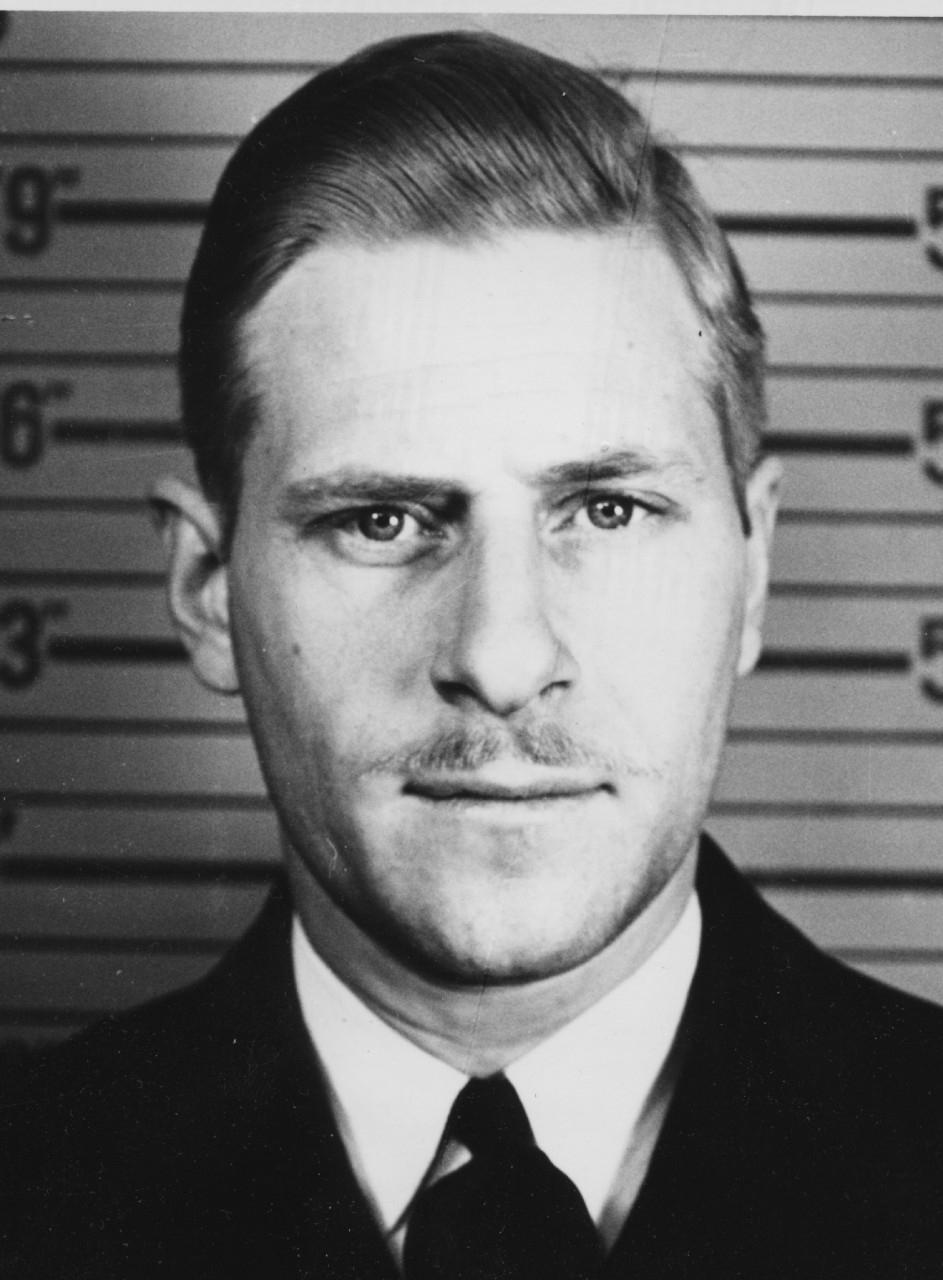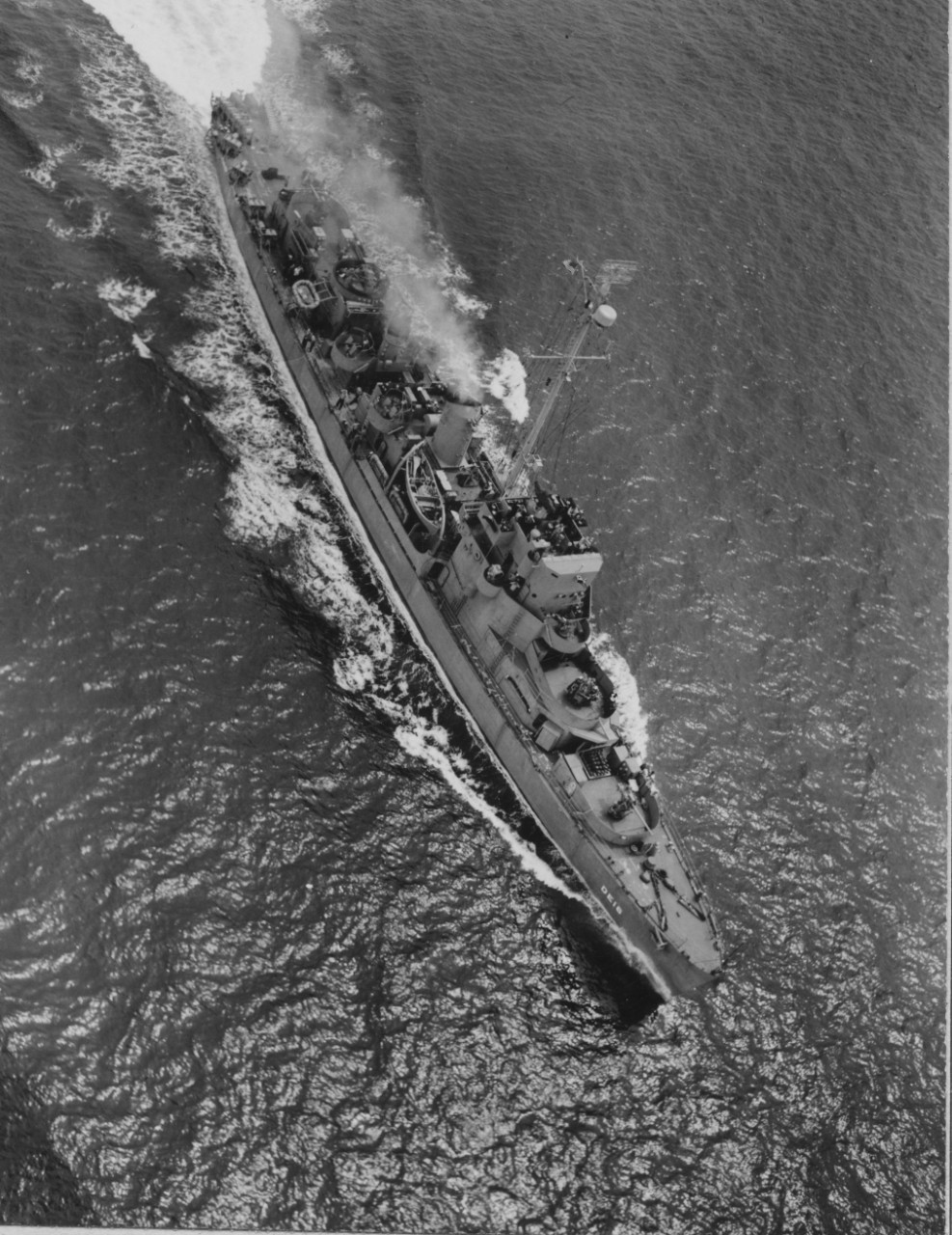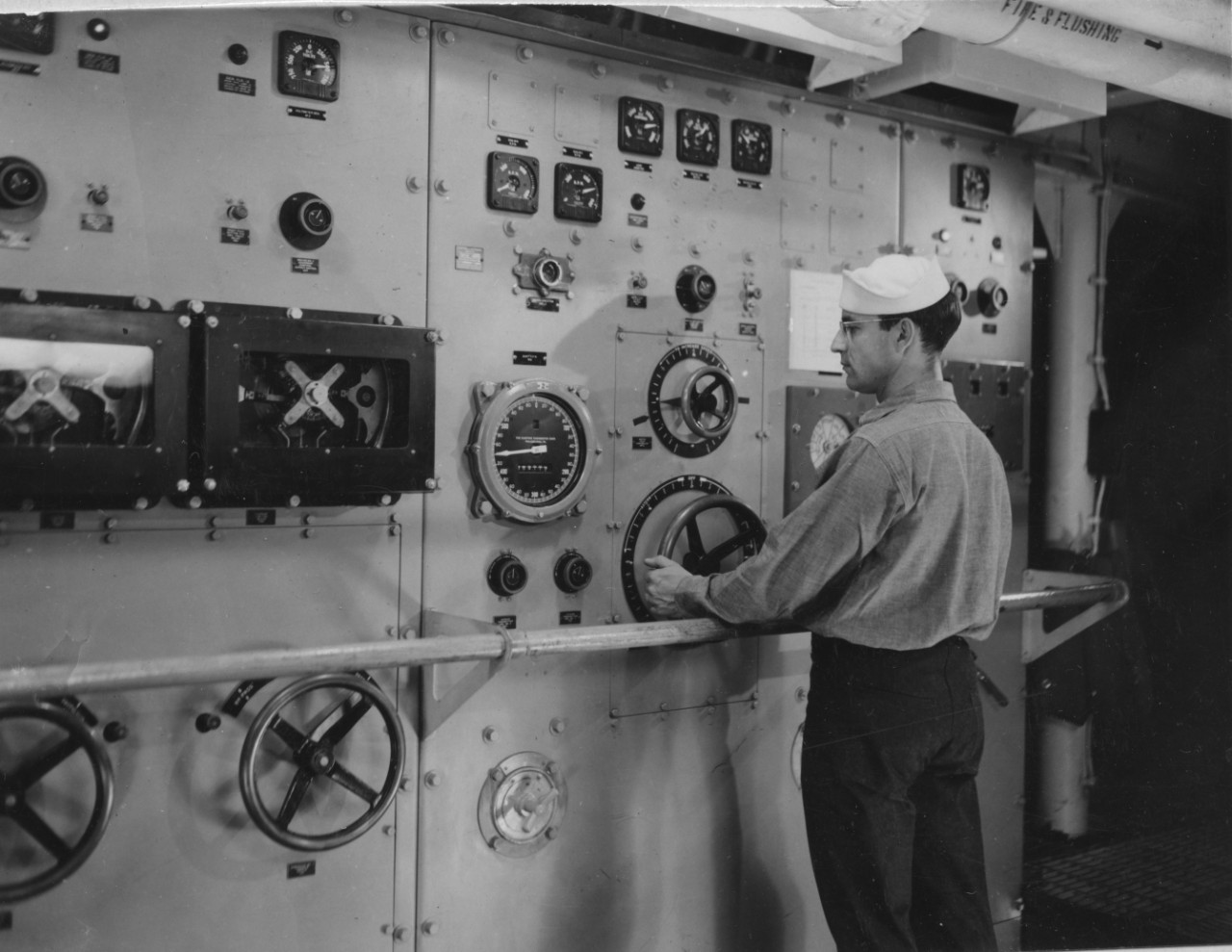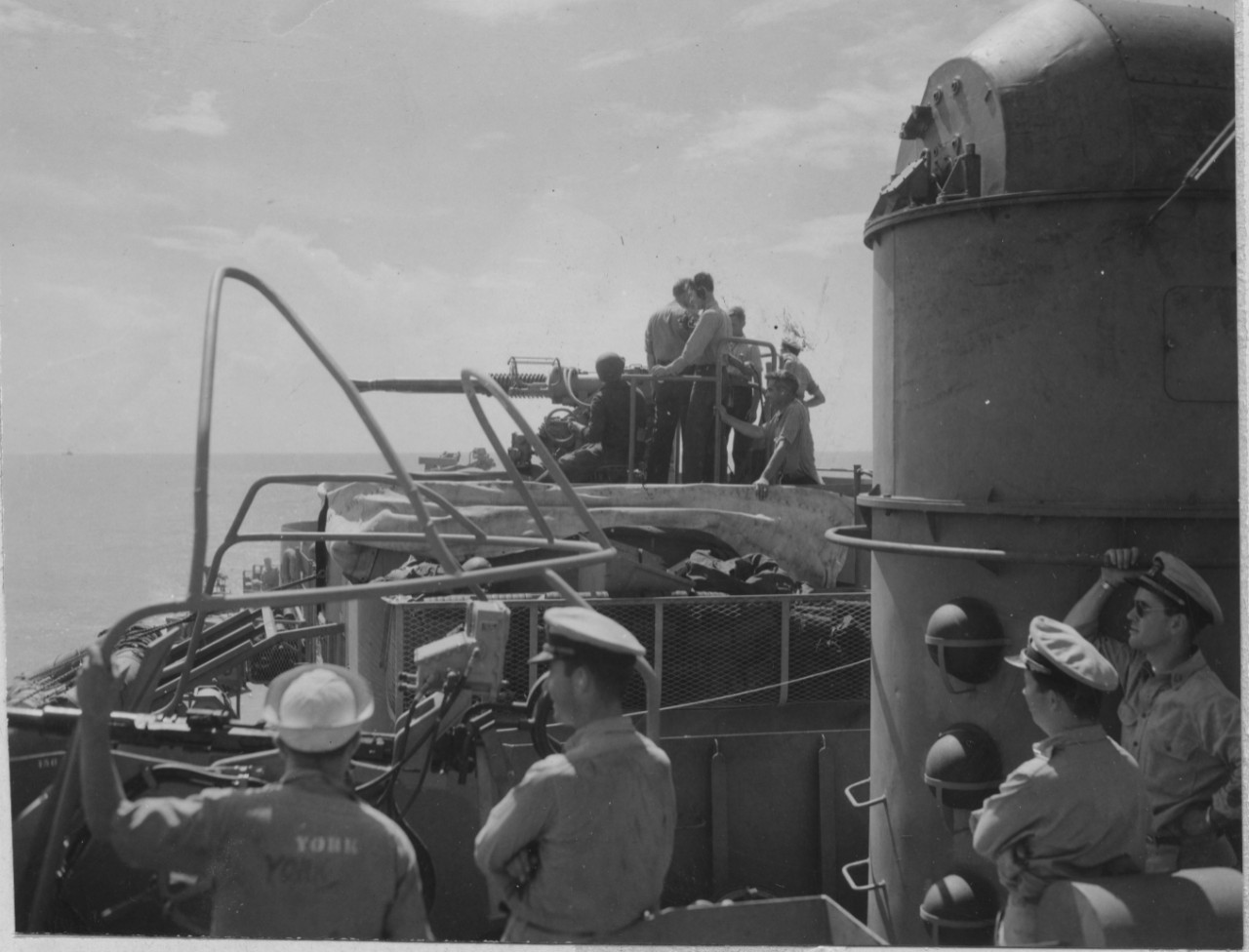Edgar G. Chase (DE-16)
1943-1945
Edgar Griffith Chase – born on 12 September 1910 in Washington, D.C., to Enoch A. and Evelyn O. Chase – was appointed midshipman from the state of Kansas by Senator Arthur Capper on 29 June 1928. Commissioned ensign from 2 June 1932 upon graduation from the U. S. Naval Academy (USNA), Chase accepted his appointment and executed his oath of office the same day.
Ens. Chase reported to his first ship, Texas (BB-35), on 29 June 1932, and with the exception of a brief tour in the Eleventh Naval District (26 March – 3 May 1934), served in that battleship until 19 November 1934. During that time, Chase participated in relief efforts carried out by the Navy in the wake of the earthquake that devastated Long Beach, Calif., on 10 March 1933, receiving the thanks of that city’s chamber of commerce for his service. Following a brief period in California (BB-43) (19-26 November 1934), Ens. Chase reported to the Puget Sound Navy Yard, Bremerton, Wash., on 26 November 1934 for duty in connection with fitting out the new destroyer Worden (DD-352). Subsequently, he remained in Worden following her commissioning, and received promotion to lieutenant (junior grade), on 26 August 1935, to date from 2 June.
Detached from Worden on 5 March 1936, Lt. (j.g.) Chase traveled to the Asiatic Station, and reported on board the destroyer Stewart (DD-224) on 4 May 1936. He was serving in that ship when Japan invaded China on 7 July 1937, and when hostilities between those two Asiatic powers threatened the International Settlement in Shanghai, China, that summer and autumn. Detached from Stewart on 17 September 1938, Chase returned to the U.S. and three months later joined the frigate Constitution on 17 December 1938. After serving on board that historic vessel, he returned to his alma mater for duty on the faculty of the U.S. Naval Academy. Detached from Constitution on 4 August 1939 he reported to the USNA on 18 August, and four months later, in a ceremony held in the Academy Chapel, Chase wed Miss Elva Hughes, a union that would produce a son, Griffith.
Detached from the USNA on 25 May 1940, Chase reported to the destroyer Shaw (DD-373) on 12 June, for service as the ship’s engineer officer. A few weeks later, he received promotion to lieutenant, to rank from 1 July.

Chase’s service in destroyers continued as he received assignment to assist in fitting out Meredith (DD-434), then building at the Boston (Mass.) Navy Yard. Detached from Shaw on 14 January 1941, Lt. Chase joined his new ship on 27 January. Initially, he served as Meredith’s engineer officer from her commissioning on 1 March 1941, then fleeted up to executive officer on 14 February 1942, just days before the ship sailed for Norfolk, screening the battleship Washington (BB-56). During that period, Meredith operated principally in the Atlantic.
Meredith screened Hornet (CV-8) when that carrier was transferred to the Pacific and, soon thereafter, transported USAAF North American B-25 Mitchell bombers that attacked Japanese targets on 18 April 1942 in the Halsey-Doolittle Raid. The destroyer then escorted oilers to New Caledonia, then the seaplane tender Tangier (AV-8) back to Pearl Harbor, then rode shotgun on a reinforcement convoy to Guadalcanal. During that period of escort work, Chase received appointment to the grade of lieutenant commander, for temporary service, on 15 June 1942, to rank from that date.
Ultimately, as Task Unit (TU) 62.4.6, Meredith was escorting the fleet tug Vireo (AT-144) (that had Pan American Airways Barge PAB-4 in tow), when she received word of an inbound Japanese air strike on 15 October 1942. Cmdr. Harry E. Hubbard, Meredith’s commanding officer, prepared for battle, ordering Vireo’s crew to come on board the destroyer so that the tug could be scuttled to avoid her falling into enemy hands. Before the destroyer could carry out that plan, however, planes from the Japanese carrier Zuikaku overwhelmed Meredith with bombs and torpedoes and sank her. While some Meredith survivors reached Vireo, which the enemy had providentially left intact, others proved not as fortunate, with Lt. Cmdr. Chase dying of exposure on 17 October.
(DE-16: displacement 1,140; length 289'5"; beam 35'2"; draft 8'3"; speed 2 knots; complement 156; armament 3 3-inch, 4 40 millimeter, 9 20 millimeter, 2 depth charge tracks, 8 depth charge projectors, 1 depth charge projector (hedgehog); class Evarts)
Burges (BDE-16), intended for the Royal Navy under Lend Lease, was laid down on 14 March 1942 at Vallejo, Calif., by the Mare Island Navy Yard; christened on 26 September 1942 by Mrs. Anne Bennett Wichels, wife of Ernest D. Wichels, Chief Clerk of the Mare Island Navy Yard; reallocated to the U.S. Navy on 19 February 1943; and commissioned as Edgar G. Chase (DE-16) on 20 March 1943, Lt. Cmdr. John J. Morony in command.
Edgar G. Chase completed her initial outfitting and sailed to Naval Base, San Diego, Calif., arriving on 9 April 1943 to begin her shakedown period. On 14 April, Edgar G. Chase departed San Diego to continuing her shakedown en route to the Atlantic for convoy escort and anti-submarine training near Bermuda. She transited the Panama Canal on 26 April 1943 and arrived at Great Sound, Bermuda, on 1 May.
Edgar G. Chase began training for convoy escort operations on 5 May 1943, conducting exercises with Reuben James (DE-153). Her first experience in hunting submarines came the next day with R-9 (SS-86) serving as her prey. Throughout May 1943, she continued a rigorous training schedule with an increasing number of ships, initially working almost exclusively with Reuben James and R-9. As the training continued, she was soon operating with sister ships Evarts (DE-5), Wyffels (DE-6), and Griswold (DE-7), Edsall (DE-129), R-15 (SS-92), and the destroyer tender Hamul (AD-20).

Upon successfully completing working up, Edgar G. Chase departed Great Sound for Charleston (S.C.) Navy Yard on 25 May 1943. She arrived on 27 May and immediately underwent upkeep and repair. She exited the yard (3 June) getting underway for the Sub Chaser Training Center (SCTC) at Miami, Fla., to begin her active career as a school ship with Escort Task Group 23.2. Edgar G. Chase arrived at the SCTC on 5 June and put to sea with her first class of students (9 June) in company with Reuben James. She spent the next thirteen months conducting escort and antisubmarine training in the Dry Tortugas.
While engaged in such evolutions on 13 June 1943, Reuben James reported detecting submerged propeller noise. Edgar G. Chase immediately shut down her engines and quickly confirmed the sound contact with her own equipment. Reuben James pursued the contact and launched her depth charges in series of five each. Edgar G. Chase went to general quarters and quickly joined in the hunt. Approximately an hour and a half later, she reestablished the sound contact, increased her speed to pursue and fired her hedgehog. The projectiles exploded immediately upon contact with the surface. Edgar G. Chase then launched eleven depth charges. Although the ship’s records do not indicate a confirmed kill, her logs report seeing debris in the water near the point of the explosions and her lookouts reported the strong smell of diesel fuel.
When not underway with students from SCTC, Edgar G. Chase would be drydocked for hull cleaning, general maintenance, and repairs by the Dade Dry Dock Co., Hialeah, Fla. several times during late 1943. She continued conducting training s between Miami, Key West, and the Dry Tortugas as she moved into 1944. While at sea, 15 miles east of Miami on 3 July, Commander Gulf Sea Frontier (ComGulfSeaFron) ordered Edgar G. Chase to make her best speed to join the Coast Guard cutter Pandora (WPC-113) off Boynton Beach, Fla. Pandora, in the company of the 83-foot patrol boat CG-83524, made a sonar contact and expended her depth charges. Edgar G. Chase arrived on station and assumed tactical command. The three vessels formed a line and began sweeping the area. Running low on fuel, CG-83524 broke formation five hours later. ComGulfSeaFron ordered Pandora to return to her regular duties while Edgar G. Chase continued to search independently.

On 4 July 1944, Independence Day, PC-1149, PCE-851, PC-1171 and SC-652 arrived to join Edgar G. Chase, the group receiving orders to continue the search moving northward 103 nautical miles to a point 24 nautical miles southeast of Port Canaveral, Fla. While en route, PC-1171 reported something on her sonar. She attacked but was unable to maintain sonar contact. PC-1171 ultimately determined the contact was not an enemy submarine. After arriving at the designated coordinates, the group received directions to alter course southerly to a point off Fort Pierce, Fla. PC-1171 once again reported a sonar contact and launched an attack on 5 July. The remaining ships of the formation executed an emergency 90° turn to join in the fight. PC-1171 reported a solid sonar contact and hearing screw noises on her sound equipment but could not close on the target. Based upon that information, Edgar G. Chase launched a pattern of thirteen depth charges. It later was determined, however, that a potential derangement of the sonar equipment onboard PC-1171 had provided a false echo. The line continued south with no other contacts or incidents. The search was abandoned and Edgar G. Chase returned to the SCTC (6 July).

After a period of upkeep in Charleston (10-21 July 1944), Edgar G. Chase made only a brief return to the SCTC before being detached for escort duties. On 30 July, she was order to proceed to Hampton Roads, Va., to join Task Group (TG) 27.2 to escort the escort carrier Tripoli (CVE-64) to Recife, Brazil (1-13 August). The force was dissolved upon arrival and Edgar G. Chase, in company with Solomons (CVE-67) and escort vessel O’Toole (DE-527) returned to Norfolk. Under orders from Commander in Chief, Atlantic Fleet, Edgar G. Chase and O’Toole were detached and proceeded to the New York Navy Yard, Brooklyn, N.Y., where the former was assigned to Escort Division (CortDiv) 80 on 26 August.
Edgar G. Chase remained at New York until getting underway for the British Isles as part of barge convoy NY-119 (19 September 1944). She served as escort for the venerable oiler Maumee (AO-2) and the fleet tug Abnaki (ATF-96) in concert with destroyers John J. Powers (DE-528), Mason (DE-529), and John M. Bermingham (DE-530). For the first few days, NY-119 sailed in smooth seas. Things took a turn for the worse, however, when a storm scattered the convoy on 26 September. During the tempest, the Army tug ST-719 foundered and the crew abandoned her as she sank approximately 820 nautical miles off the coast of Virginia. Other ships in NY-119 rescued all but two of her sailors. Edgar G. Chase and the other escorts then spent the remainder of the day shepherding the battered convoy.
On 16 October 1944, weather again hampered NY-119’s progress. Roughly 300 nautical miles west of Falmouth, Cornwall, U.K., high winds and seas caused the convoy to split up with the escorts dividing up to remain with various components. The following day, the convoy commodore dispatched Edgar G. Chase to locate Army tug LT-537. The tug, with a barge under tow, had lost contact with the convoy in the heavy seas. The escort vessel located LT-537 with her tow intact, but on 18 October, the tow broke free, and the continuing bad weather prevented any attempt to recover it. Determining that the weather continued to be a threat to LT-537, Edgar G. Chase escorted her to leeward of the Scilly Islands to ride out the storm. After the tug was out of harm’s way, Edgar G. Chase steamed to rejoin NY-119. She assisted locating other ships that separated from the main body.
After locating another straggler, LT-581, the following day, both vessels returned to the Scilly Islands to collect LT-537 then set a course for Falmouth. While en route, the group came upon a lone barge that appeared to be adrift. LT-581 continued on course while Edgar G. Chase and LT-537 attempted to recover the errant barge. LT-539 made up a towline only to discover the craft was anchored. The tug remained tethered to the barge through the night (19 October 1944). The following morning, as weather conditions rapidly deteriorated, LT-539 cut the towline and steamed to Falmouth with Edgar G. Chase.
While en route, Edgar G. Chase made a sonar contact. She made several runs on the target, launching a full pattern with her hedgehog. Once she ceased firing, it was determined that the target was merely a bottom echo. She rejoined LT-539 on course to Falmouth. Along the way, the two vessels encountered LT-63, with LT-643 in tow, from NY-119. The storm battered group entered Carrick Roads on 20 October 1944.
After only a brief respite, Edgar G. Chase got underway for Plymouth, Devon, in company with Abnaki and John M. Bermingham the next day. On 22 October 1944, she returned to the English Channel with John M. Bermingham, Abnaki, and LT-374 to search for drifting barges that had been sundered from convoys. Abnaki discovered one barge adrift and towed it into Falmouth. Edgar G. Chase and LT-374 continued the search into the North Atlantic. The two vessels discovered a drifting barge 20 nautical miles south of the Scilly Islands. While LT-374 attempted to attach a towline to the barge, a hawser fouled her screws. Edgar G. Chase requested Abnaki to proceed to their position to recover the barge. On 24 October, Edgar G. Chase made her way to Plymouth with LT-574 in tow, leaving Abnaki alone to recover the barge once the weather improved.
Edgar G. Chase remained at Plymouth until sailing for Norfolk on 6 November 1944 along with John J. Powers, Mason, John M. Bermingham, Maumee, net layers Shellbark (AN-67) and Pinon (AN-66), and eight Army tugs. The return voyage home proved uneventful, blessed with fair weather and calm seas. Roughly 500 nautical miles east of Norfolk on 19 November, John J. Powers and John M. Bermingham were detached from the convoy to escort the tugs to New York, while Edgar G. Chase and Mason continued on, escorting the remaining ships of the convoy to Norfolk. After safely arriving at their destination on 22 November, the two escort destroyers were relieved of their duties during the mid watch (0310) and by 1715, both ships moored at New York for upkeep and voyage repairs.
In early December 1944, Edgar G. Chase was participating in antisubmarine training exercises at Casco Bay, Maine, where the Italian submarine Vortice and S-14 (SS-119) portrayed enemy combatants. On 12 December, Commander Destroyers Atlantic (ComDesLant) ordered her to Norfolk to assist in testing underwater caissons. While steaming at 18 knots, she encountered high winds and heavy seas that caused some damage and prompted her to reduce speed, and she ultimately reached Norfolk on 14 December.
On 19 December 1944, Edgar G. Chase was once again crossing the Atlantic. On that voyage, she was bound for Oran, Algeria, via the Strait of Gibraltar with convoy U.S. to Gibraltar (UGS) 64. Her company comprised the destroyers Balch (DD-363), Livermore (DD-429), and Eberle (DD-430), the frigate Gulfport (PF-20), and escort vessels O’Toole, Andres (DE-45) John J. Powers, John M. Bermingham, and Mason. As the convoy steamed 230 nautical miles west of Gibraltar, UGS-64 received word that the U.S. freighter Henry Miller, steaming in an eastbound convoy, Gibraltar to the U.S. (GUS) 63, had been torpedoed outside the strait (3 January 1945) by the German submarine U-870 (Korvettenkapitän Ernst Hechler, commanding).
As a precaution, Edgar G. Chase deployed a towed device [FXR, or Foxer] initially developed by the Royal Navy and later adopted by other allied naval forces. Foxer was designed to defeat acoustically homing German torpedoes. UGS-64 safely transited the Strait of Gibraltar on 4 January 1945 and split in to three sections. Edgar G. Chase and Livermore, with their charges, set a course for Oran, Algeria. The next day, Edgar C. Chase moored at Mers-el Kébir next to the hulk of the former Vichy French destroyer Épervier.
On 12 January 1945, Edgar G. Chase was providing escort to GUS-65 sailing to Norfolk in the company of Livermore, Andres, Eberle, and John M. Bermingham. The return voyage proved relatively uneventful with neither sonar contacts nor severe weather, but approximately 560 nautical miles east of Bermuda, Edgar G. Chase searched for a man washed overboard (25 January) from the U.S. freighter John Constantine. Sadly, after a three and half hour search, the sailor was not found. As the convoy approached the eastern seaboard, 400 nautical miles southeast of Norfolk, Andres and Edgar G. Chase left the formation for Hampton Roads. At 1730 on 1 February 1945, she was relieved from escort duty and set a course for New York where she remained undergoing repairs until 15 February 1945.
Edgar G. Chase departed for Oran, Algeria, on 16 February 1945 with Nelson (DD-623) and Andres to rendezvous with UGS-75. The group joined the main body of the convoy the following day along with fellow escorts Livermore, John M. Bermingham, and the frigate Annapolis (PF-15). On 23 February, Edgar G. Chase made a sonar contact and attacked the target without result. The convoy transited the Strait of Gibraltar on 4 March 1945. Edgar G. Chase, along with Nelson, Andres and Annapolis, left the main body of UGS-75 to escort their assigned merchantmen to Oran. One of those vessels began to straggle from the convoy requiring Edgar G. Chase to lag behind the main formation to provide her protection, the two ships standing in to the Gulf of Oran on 12 March. The next day, Edgar G. Chase got underway for Norfolk as an escort for GUS-77. She continued to provide escort services between Norfolk and Oran through the end of the war in Europe, and completed her last transatlantic voyage on 30 May.
Edgar G. Chase remained moored at New York, undergoing maintenance for the month of June 1945, then shifted to Casco Bay for training (1-15 July). On 16 July, Edgar G. Chase set course for the Naval Training Center (formerly SCTC) Miami, arriving four days later. She operated out of that port, serving as a school ship, in the waters of the Dry Tortugas, the Florida Keys, and north of Havana, Cuba, until early September when she arrived at the Charleston Naval Shipyard to prepare for inactivation.
Decommissioned at Charleston on 16 October 1945, Edgar G. Chase was stricken from the Navy List on 1 November 1945. Ultimately, the veteran of convoy escort work in the Atlantic was sold to Edward Goodman, of Harris Structural Steel of New Jersey, on 18 March 1947, and subsequently broken up for scrap.
Robert J. Cressman (biography), John W. Watts (history)
19 May 2017


